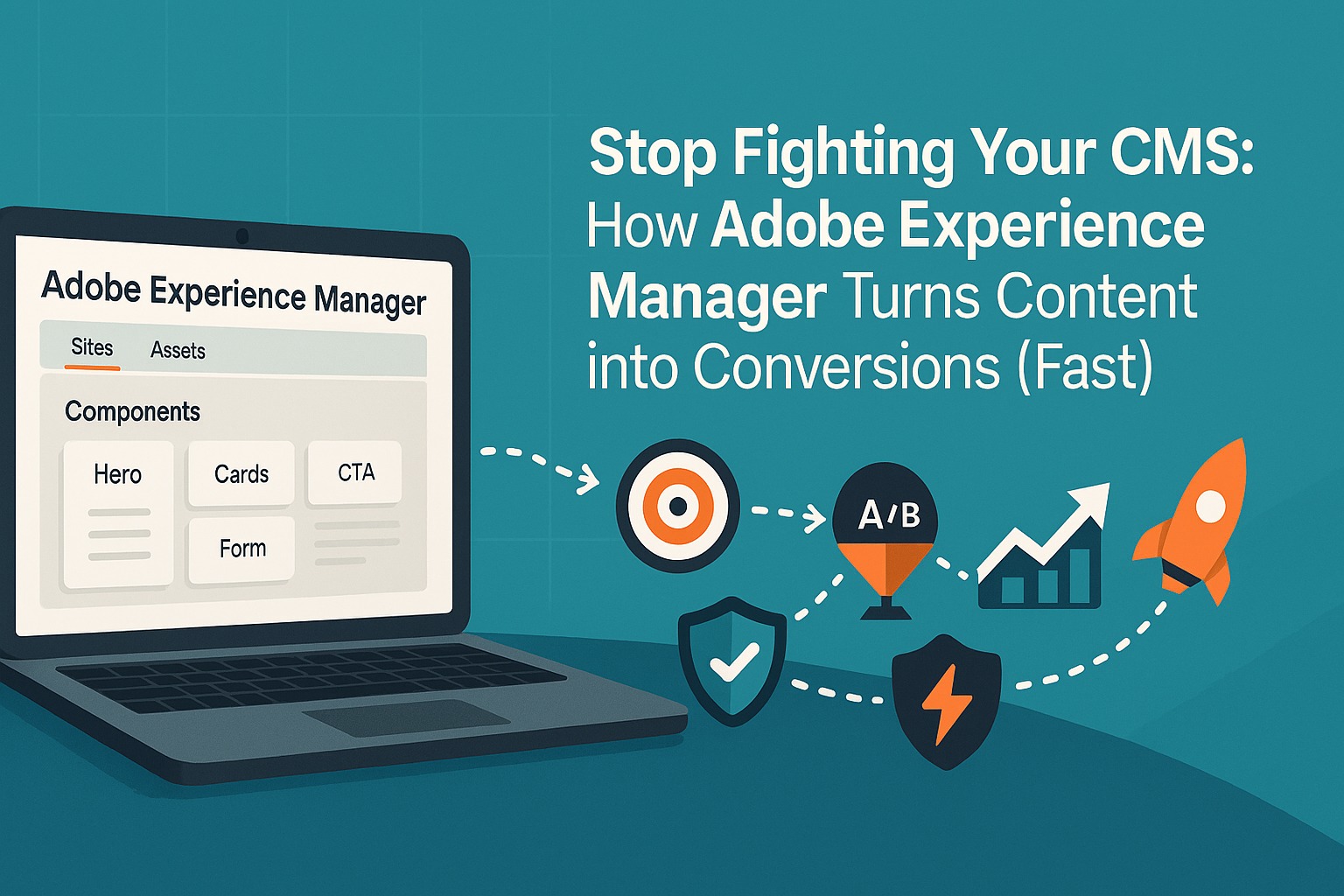Tired of wrestling with a clunky CMS every time you launch a page or campaign? You’re not alone. Most teams struggle with slow authoring, inconsistent brand experiences, and releases that drag on for weeks.
Key Takeaways
- AEM streamlines authoring with reusable components and a visual editor
- Built-in governance keeps brand, access, and compliance under control
- Personalization and experiments connect content to measurable conversions
- Cloud-native scale and integrations accelerate time-to-value
- Teams ship faster with fewer handoffs and less rework
Why teams “fight” their CMS
The most common CMS pain points look the same in India, the USA, and Canada:
- Authoring bottlenecks: Content authors depend on developers for basic page changes. Every tweak becomes a ticket.
- Slow releases: Hard-coded templates and brittle plugins turn launches into mini-projects.
- Fragmented assets: Images and copy live in folders, emails, and desktops - nobody’s sure which version is final.
- Governance gaps: No clear permissions, no approval flow, and no audit trail.
- Limited personalization: Content ships “one-size-fits-all,” so conversion optimization stalls.
Result: good ideas die in backlog queues. Marketing waits. Engineering burns out. Customers bounce.
How AEM fixes the bottlenecks
Adobe Experience Manager (AEM) takes a platform approach - Sites for web experiences and Assets for centralized digital asset management - so your team works from one source of truth.
- Visual, component-based authoring: Drag-and-drop blocks built by developers once, reused by authors everywhere - no code needed.
- Content modeling for scale: Define content types (e.g., product, course, story) and publish them to multiple channels from a single model.
- Governance by design: Role-based permissions, workflows, and version history keep your brand consistent and compliant.
- AEM Assets at the core: Auto-renditions, smart tagging, and rights management make assets findable and on-brand.
- Cloud service and automation: Continuous updates, performance tuning, and security patches handled for you - less ops, more outcomes.
Want the official details? See Adobe’s AEM Sites overview in Experience League (clear docs on authoring, templates, and deployment).
From content to conversions
Publishing fast matters - but converting matters more. AEM connects the dots:
- Personalization: Serve variations by audience, location, device, or behavior.
- Experimentation: Test headlines, CTAs, or hero sections and roll out winners.
- Analytics hand-off: Clean data layers and tight integrations give analysts what they need - without manual tagging marathons.
- Omnichannel delivery: Publish to web, mobile apps, kiosks, and emerging channels from the same content model.
The result is content velocity + relevance: you don’t just ship more; you ship what resonates.
AEM in action: launch a campaign in days, not weeks
Hypothetical scenario:
A mid-size edtech brand needs a “Fall Enrollment” campaign for India, the USA, and Canada.
- Plan: Product marketing drafts the offer and target segments.
- Assemble: An author builds pages using pre-approved components and pulls assets from AEM Assets - no design hunt.
- Localize: Regional teams duplicate the page, swap copy, and apply geo-specific banners in minutes.
- Personalize: First-time visitors see program overviews; returning visitors see price breaks or deadlines.
- Measure: Analysts review experiments and funnel metrics; the team promotes the best-performing variant.
In under a week, the campaign is live in three regions with governed content, consistent branding, and clean data.
AEM vs Traditional CMS
| Capability | AEM | Traditional CMS |
|---|---|---|
| Authoring | Visual, component-based; reusable blocks | Template-bound; copy-paste or custom code |
| Scalability | Cloud-native, auto-scales | Manual scaling, plugin overhead |
| Personalization | Built-in audience targeting & testing | Add-on tools or custom dev |
| Governance | Role-based access, workflows, versioning | Limited approvals; inconsistent audit trails |
| Integrations | Deep Adobe + enterprise connectors | Varies; often plugin sprawl |
| Time-to-launch | Days with reusable components | Weeks due to dev tickets and QA |
Quick Wins in Your First 30 Days on AEM
Checklist
- Identify 5 high-impact components (Hero, Card Grid, FAQ, CTA, Price Table)
- Centralize top 100 assets in AEM Assets with tags and usage rights
- Convert 3 recurring pages into content models (e.g., Product, Course, Event)
- Launch one A/B test on your homepage CTA
- Define a publish workflow with approvers and SLAs
Getting started with AEM (skills, setup paths, training options)
Skills: Authors learn components, page building, and basic personalization. Developers handle component design, content models, and integrations. Admins manage permissions and workflows.
Setup paths:
- Start with a pilot site or section to prove value quickly.
- Standardize components and content types.
- Migrate high-traffic pages and priority assets first.
If you want guided, hands-on learning, explore AEM Training Online - a practical way to go from theory to shipping in weeks.
FAQs
What is Adobe Experience Manager (AEM)?
AEM is Adobe’s digital experience platform for creating, managing, and delivering content across websites and channels at enterprise scale.
Is AEM only for large enterprises?
No. While enterprise-ready, mid-market teams adopt AEM for its governance, speed, and personalization - especially when growth demands consistency.
Can AEM work headless?
Yes. AEM supports headless delivery via content APIs so you can power websites, apps, and devices from a single content source.
How does AEM help SEO?
Clean markup, fast performance, and structured content models improve crawlability, while authoring speed helps you publish fresh, relevant content.
What about migration from a legacy CMS?
Start with a component library and content models, migrate high-value pages first, and use redirects and QA to protect rankings.
Ready to turn content into conversions - fast?
Whether you’re a student upskilling in AEM or a professional owning pipeline targets, the next step is simple: standardize components, centralize assets, and launch your first experiment. SV Soft Solutions can help you implement AEM, train authors, and connect content to results.
